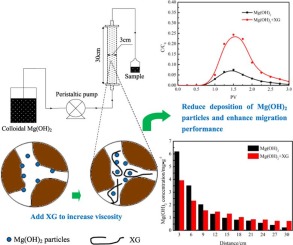Environment International ( IF 10.3 ) Pub Date : 2020-03-20 , DOI: 10.1016/j.envint.2020.105658 Bowen Li , Shengyan Pu , Sandip Mandal , Miao Li

|
Mg(OH)2 is extensively considered as an potential material for groundwater remediation because its injection could provide a long-term pH buffering system. In this study, colloidal Mg(OH)2 was regarded as an alternative reagent for the in-situ remediation of heavy metal polluted groundwater. However, experiments demonstrated that the transport performance of colloidal Mg(OH)2 in groundwater was depressed by the contamination of heavy metals and its stabilization performance for heavy metals was deteriorated. To solve these difficulties, the transport properties of colloidal Mg(OH)2 was enhanced by viscosity modification by adding xanthan gum (XG). Column tests were conducted to investigate the transport performance of colloidal Mg(OH)2 with and without viscosity modification, and to evaluate its stabilization effect for Pb and Cd polluted aquifer. Experimental results indicate that although the injection pressure increased during the migration of colloidal Mg(OH)2, the increased viscosity effectively could decrease the intensity of Brownian motion of Mg(OH)2 particles and reduce the collision efficiency between colloidal particles and aquifer media. Thus, deposition of Mg(OH)2 particles on aquifer media significantly reduced after viscosity modification, and its migration performance in groundwater was effectively enhanced. In contrast, the distribution of colloidal Mg(OH)2 was more uniform after viscosity modification, and immobilization of heavy metals in contaminated aquifer was noticeably improved, furthermore the exchangeable fraction of Pb and Cd is significantly reduced.
中文翻译:

粘度调节增强了胶体Mg(OH)2在重金属污染的含水层中的迁移和分布
Mg(OH)2被广泛视为地下水修复的潜在材料,因为其注入可提供长期的pH缓冲系统。在这项研究中,胶体Mg(OH)2被视为原位修复重金属污染地下水的替代试剂。然而,实验表明,重金属的污染会降低胶体Mg(OH)2在地下水中的传输性能,并且其对重金属的稳定性能会下降。为了解决这些困难,胶体Mg(OH)2的传输性质通过添加黄原胶(XG)进行粘度调节,可提高粘度。进行柱试验以研究具有和不具有粘度改性的胶体Mg(OH)2的传输性能,并评估其对Pb和Cd污染的含水层的稳定作用。实验结果表明,尽管在胶体Mg(OH)2迁移过程中注入压力增加,但增加的粘度可有效降低Mg(OH)2颗粒的布朗运动强度,并降低胶体颗粒与含水层介质之间的碰撞效率。因此,Mg(OH)2的沉积粘度改变后,含水层介质中的颗粒明显减少,有效地提高了其在地下水中的迁移性能。相比之下,胶体Mg(OH)2的粘度改变后分布更加均匀,重金属在受污染含水层中的固定化得到显着改善,而且Pb和Cd的可交换分数也大大降低。











































 京公网安备 11010802027423号
京公网安备 11010802027423号